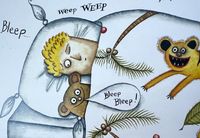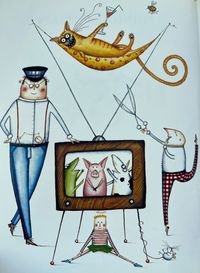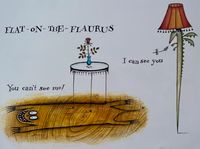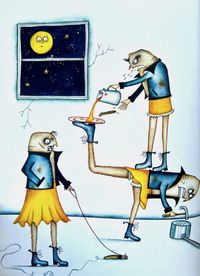"I am a mat and I matter."
I write a lot of nonsense. Quite a bit. A spitz-woggler of nonsense. "Nonsense is the breath of my nostrils," wrote Edward Lear, the Victorian originator of what we term nonsense. Lear's contribution to the field included an inventive alphabet; reimagined verse that influenced Lewis Carroll's Looking-Glass Lands; and a perfect little tale of a man who gets carried away by the wind.
Birds flying backward and tea pouring upward notwithstanding, nonsense and its more forked-tongue cousin, absurdity, thematically fit with the intentional purpose of The Examined Life. If nothing is what it ought to be, what ought things to be? It is on humans to set these standards, to adjust to the nonsense while maintaining some vestige of what we call humanity.
 "Bleep! Weep! Weep! Bleep! Bleep! Illustration by Claire Mackie.
"Bleep! Weep! Weep! Bleep! Bleep! Illustration by Claire Mackie.In 1997 (nonsense off the Richter scale that year, those insolvent Dot-Coms) Michael Rosen, a children's book author in the spitz-woggler (A Dahl word of course) tradition of nonsense, collaborated with illustrator Claire Mackie to deliver the wonderfully fantastic Book of Nonsense.
Splish Splash
When I walk across the room
I hear a splash and a splish
There's something under the rug.
I think it's a jellyfish.
What if there are jellyfish under the rug? What if fairies are sprucing up the garden hollows or if snails move to their desired ends in contemplative conversation? What if what if what if? What is the line between reality and the impossible? Do we know it, did humans who lived before us know it? What is the role of certainty and doubt in determining that line?
Help, help
Help, help
nothing's right
I can't find my ears
and my pants are too tight.
There's a clock in my sock
there's a rose up my nose
there's an egg on my leg
and there's a stink in the sink.
Help, help
I've had enough
I can't find my eyes
and the going's getting tough.
There's bread in my bed
there's flies in my friends
there's a slug in the jug
and there's a ghost on my toast.
Nonsense is not only a departure from reality, it is a subtle question: If nothing is what it ought to be, what ought things to be? It is a question illuminated by the hell-fires of Covid, the seasonal arrival of land fires, of the crisis in the Middle East which has tipped all of us - so known to its violence by now - beyond anything that ought to be. And so many more human-made instances.
 Illustration by Claire Mackie.
Illustration by Claire Mackie.Nonsense is the acknowledgment of agitation, abeyance of grief, and an ego-usurping need to reclaim the world with our bare hands and throttle it into sense. From madness to order, from order to madness in a cycle we pretend to control. A cycle we pretend is not a cycle by all but a line, ever advancing towards better humanity.
Rosen chases down that exact feeling of nonsense:
GNORW
It's all gone wrong
the singer's lost her song,
She lost the key to her apple
and the bell has lost its bong.
Would should she do?
The pickle's in a stew
She lost the switch to her orange
and the shine has lost its shoe.
How I adore the line "The shine has lost its shoe." The two go together, no? Shine and shoe. As a pair of words, or objects in dialogue. Of course, one could lose the other, why do we afford the agency to the shoe rather than the shine?
Has anything lost you recently? A smile, a shadow, a thought?
 "Flat-on-the-Flaurus." Illustration by Claire Mackie.
"Flat-on-the-Flaurus." Illustration by Claire Mackie.Of course, nonsense is not solely about things going wrong, but rather, things being wrong. Which is more unnerving because once it's done our influence is superfluous.
Footling Around
Footle flop doodle
footle flop doodle.
You can flap your flapper
you can flop your flopper
you can clap your clapper
you can clop your clopper.
Footle flop doodle
footle flop doodle
You can foot your footle
you can fit your fittle
you can dood your doodle
you can did your diddle
Footle flop doodle
footle flop doodle.
Hungarian-born British satirist, George Mikes, wrote extensively on 20th-century British humor as an art form that expresses the inexpressible and tries to normalize changes in our society and ourselves. “Nonsense poetry is not nonsensical poetry,” argued Mikes of Lear in particular, “But poetical nonsense. It catches the imagination and often the heart; it amuses, it charms, and sometimes saddens the reader.”
 "Billy's Bully Boys." Illustration by Claire Mackie.
"Billy's Bully Boys." Illustration by Claire Mackie.Billy's Bully Boys
The people upstairs
are making a horrible noise.
We know who it is:
it's Billy's Bully Boys.
They come in late.
They've got hairy legs.
They keep pet slugs,
and put custard on their eggs.
They wear dirty jackets.
They don't bother with shirts.
On Sunday afternoons
they wear yellow skirts.
Mr. Billy's Bully Boys
like to spit and cough.
I know what I'd like:
I wish they'd clear off.
Rosen's work is just that: Amusing, charming, sometimes sad. Should you require more nonsense - artificially created nonsense that is - slip over to Edward Gorey's creature tale that pokes fun at repressive politeness, David Shrigley's visual absurdity, and other forms of humor like the understatement that allow us to go on as we all desire. Resetting how it ought to be, turning nonsense into sense.

